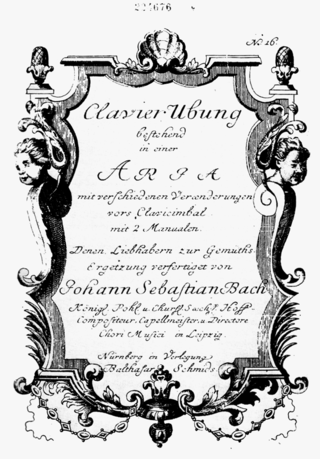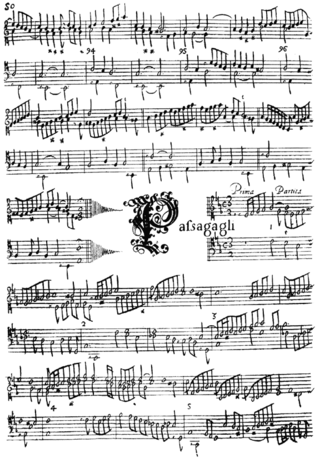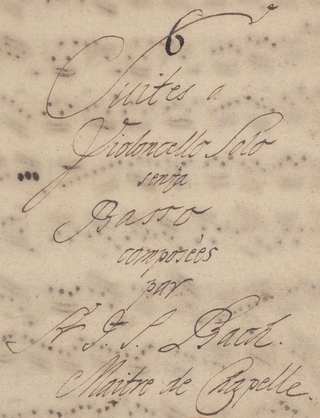Related Research Articles

In classical music, a fugue is a contrapuntal, polyphonic compositional technique in two or more voices, built on a subject that is introduced at the beginning in imitation, which recurs frequently throughout the course of the composition. It is not to be confused with a fuguing tune, which is a style of song popularized by and mostly limited to early American music and West Gallery music. A fugue usually has three main sections: an exposition, a development, and a final entry that contains the return of the subject in the fugue's tonic key. Fugues can also have episodes—parts of the fugue where new material is heard, based on the subject—a stretto, when the fugue's subject "overlaps" itself in different voices, or a recapitulation. A popular compositional technique in the Baroque era, the fugue was fundamental in showing mastery of harmony and tonality as it presented counterpoint.

The Goldberg Variations, BWV 988, is a musical composition for keyboard by Johann Sebastian Bach, consisting of an aria and a set of 30 variations. First published in 1741, it is named after Johann Gottlieb Goldberg, who may also have been the first performer of the work.

The passacaglia is a musical form that originated in early seventeenth-century Spain and is still used today by composers. It is usually of a serious character and is often based on a bass-ostinato and written in triple metre.

A suite, in Western classical music, is an ordered set of instrumental or orchestral/concert band pieces. It originated in the late 14th century as a pairing of dance tunes and grew in scope to comprise up to five dances, sometimes with a prelude, by the early 17th century. The separate movements were often thematically and tonally linked. The term can also be used to refer to similar forms in other musical traditions, such as the Turkish fasıl and the Arab nuubaat.

The six Cello Suites, BWV 1007–1012, are suites for unaccompanied cello by Johann Sebastian Bach (1685–1750). They are some of the most frequently performed solo compositions ever written for cello. Bach most likely composed them during the period 1717–1723, when he served as Kapellmeister in Köthen. The title given on the cover of the Anna Magdalena Bach manuscript was Suites à Violoncello Solo senza Basso.

The 24 Preludes and Fugues, Op. 87 by Dmitri Shostakovich are a set of 24 musical pieces for solo piano, one in each of the major and minor keys of the chromatic scale. The cycle was composed in 1950 and 1951 while Shostakovich was in Moscow, and premiered by pianist Tatiana Nikolayeva in Leningrad in December 1952; it was published the same year. A complete performance takes approximately 2 hours and 32 minutes. It is one of several examples of music written in all major and/or minor keys.
The Violin Concerto No. 1 in A minor, Op. 77, was originally composed by Dmitri Shostakovich in 1947–48. He was still working on the piece at the time of the Zhdanov Doctrine, and it could not be performed in the period following the composer's denunciation. In the time between the work's initial completion and the first performance, the composer, sometimes with the collaboration of its dedicatee, David Oistrakh, worked on several revisions. The concerto was finally premiered by the Leningrad Philharmonic under Yevgeny Mravinsky on 29 October 1955. It was well-received, Oistrakh remarking on the "depth of its artistic content" and describing the violin part as a "pithy 'Shakespearian' role."
Ronald James Stevenson was a Scottish composer, pianist, and writer about music.

Passacaglia and Fugue in C minor is an organ piece by Johann Sebastian Bach. Presumably composed early in Bach's career, it is one of his most important and well-known works, and an important influence on 19th- and 20th-century passacaglias: Robert Schumann described the variations of the passacaglia as "intertwined so ingeniously that one can never cease to be amazed."

Dmitri Shostakovich's String Quartet No. 10 in A-flat major, Op. 118, was composed from 9 to 20 July 1964. It was premiered by the Beethoven Quartet in Moscow and is dedicated to composer Mieczysław (Moisei) Weinberg, a close friend of Shostakovich. It has been described as cultivating the uncertain mood of his earlier Stalin-era quartets, as well as foreshadowing the austerity and emotional distance of his later works. The quartet typified the preference for chamber music over large scale works, such as symphonies, that characterised his late period. According to musicologist Richard Taruskin, this made him the first Russian composer to devote so much time to the string quartet medium.
DSCH is a musical motif used by the composer Dmitri Shostakovich to represent himself. It is a musical cryptogram in the manner of the BACH motif, consisting of the notes D, E-flat, C, B natural, or in German musical notation D, Es, C, H, thus standing for the composer's initials in German transliteration: D. Sch..

The French Suites, BWV 812–817, are six suites which Johann Sebastian Bach wrote for the clavier between the years of 1722 and 1725. Although Suites Nos. 1 to 4 are typically dated to 1722, it is possible that the first was written somewhat earlier.

Mark Gasser is a British concert pianist.
Orchestral Suite No. 1 in D minor is an orchestral suite, Op. 43, written by Pyotr Ilyich Tchaikovsky in 1878 and 1879. It was premiered on December 20, 1879 at a Russian Musical Society concert in Moscow, conducted by Nikolai Rubinstein. The piece is dedicated to Tchaikovsky's patroness, Nadezhda von Meck.
Olli Mustonen is a Finnish pianist, conductor, and composer.

Baroque music refers to the period or dominant style of Western classical music composed from about 1600 to 1750. The Baroque style followed the Renaissance period, and was followed in turn by the Classical period after a short transition. The Baroque period is divided into three major phases: early, middle, and late. Overlapping in time, they are conventionally dated from 1580 to 1650, from 1630 to 1700, and from 1680 to 1750. Baroque music forms a major portion of the "classical music" canon, and is widely studied, performed, and listened to. The term "baroque" comes from the Portuguese word barroco, meaning "misshapen pearl". The works of Antonio Vivaldi, George Frideric Handel and Johann Sebastian Bach are considered the pinnacle of the Baroque period. Other key composers of the Baroque era include Claudio Monteverdi, Domenico Scarlatti, Alessandro Scarlatti, Alessandro Stradella, Tomaso Albinoni, Johann Pachelbel, Henry Purcell, Georg Philipp Telemann,Jean-Baptiste Lully, Jean-Philippe Rameau, Marc-Antoine Charpentier, Arcangelo Corelli, François Couperin, Johann Hermann Schein, Heinrich Schütz, Samuel Scheidt, Dieterich Buxtehude, Gaspar Sanz, José de Nebra, Antonio Soler, Carlos Seixas and others.
Andamento is an Italian musical term used to refer to a fugue subject of above-average length.

Alexander (Gustav) Adolfovich Winkler, also Alexandre Adolfovitch Winkler, was a Russian pianist, composer and music educator of German descent.
References
- Gasser, M., "Ronald Stevenson, Composer-Pianist : An Exegetical Critique from a Pianistic Perspective" (Edith Cowan University Press, Western Australia, 2013)
- Raymond Clarke, recording notes for Stevenson: Passacaglia on DSCH. Raymond Clarke (piano). Marco Polo 8.223545.
- Chris Walton, "Composer in Interview: Ronald Stevenson - a Scot in 'emergent Africa'"
- Ronald Stevenson: A Musical Biography by Malcolm MacDonald (Edinburgh, National Library of Scotland, 1989)
- Ronald Stevenson: The Man and his Music - A Symposium edited by Colin Scott-Sutherland with a foreword by Yehudi Menuhin (London, 2005) ISBN 0-907689-40-X